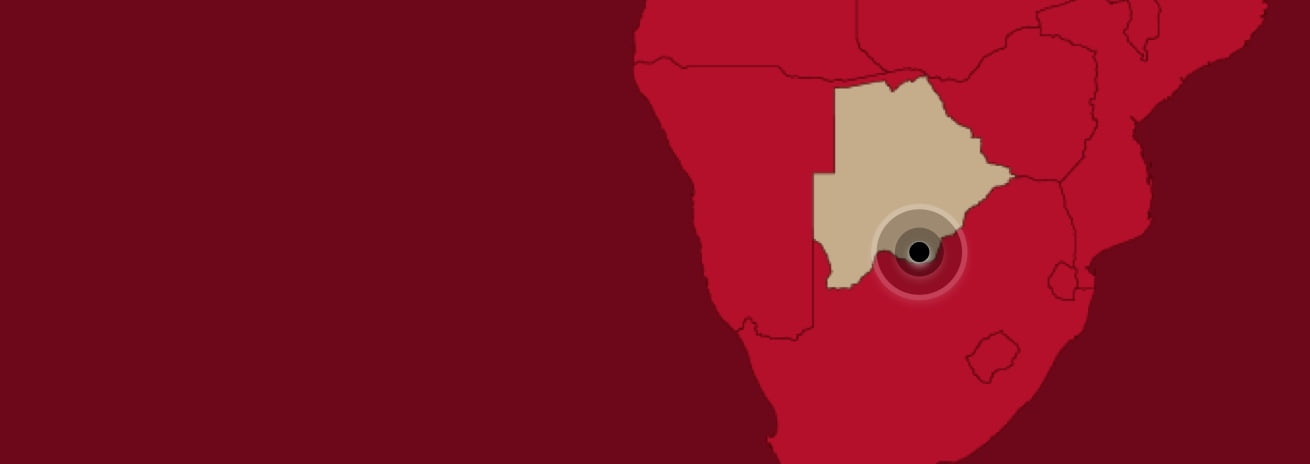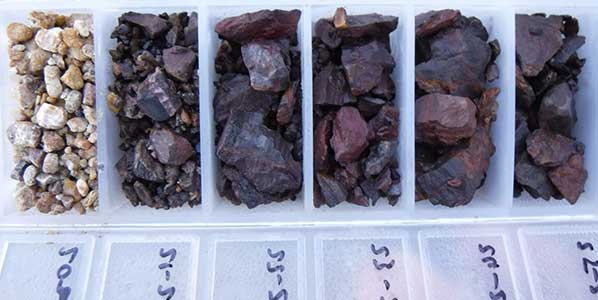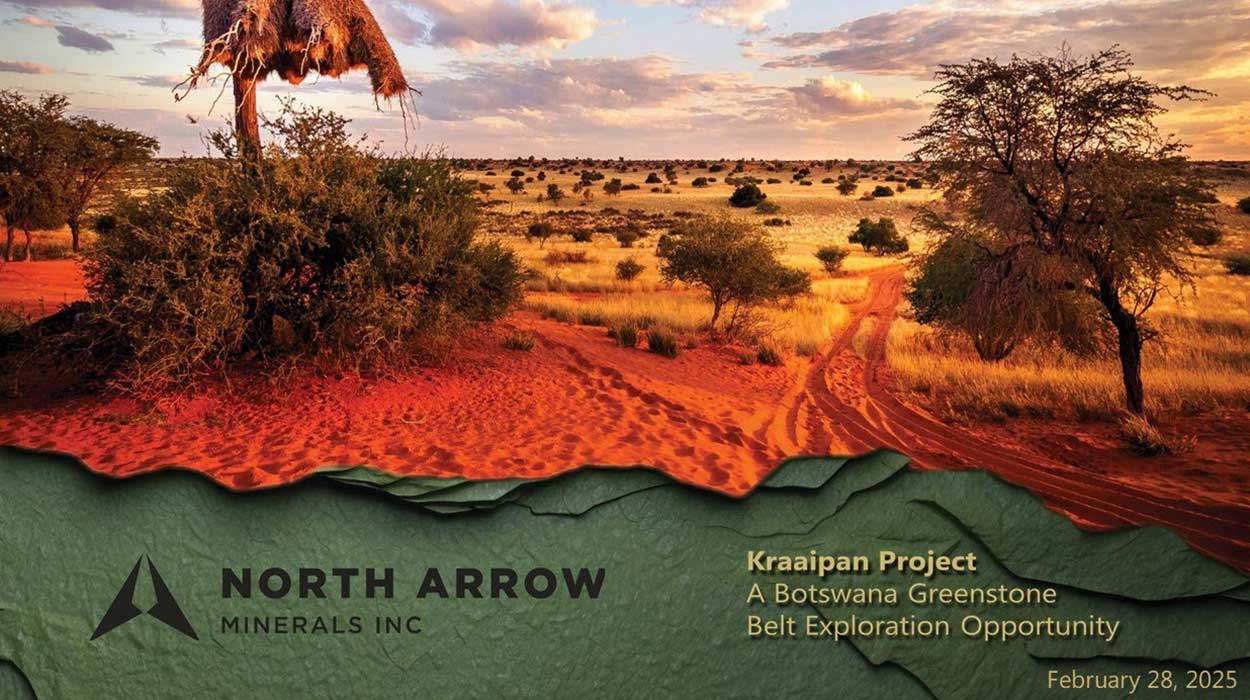Project Summary

Location
Southern District of the Republic of Botswana, north of border of South Africa
North Arrow’s exploration programs are conducted under the direction of Chairman of the Board, Ken Armstrong, P.Geo., a Qualified Person under NI 43-101. Mr. Armstrong has reviewed and approved all information posted on this page that is of a scientific or technical nature.
Size
724 km2 covering the entire ~60km northern extension of the Kraaipan Greenstone Belt
Ownership
North Arrow earning 60% from Rockman Resources Ltd (“Rockman”) by spending US$5M in three years (can earn up to 80%)
Stage
Systematic grassroots / brownfields exploration of entire property
Closest Infrastructure
Paved and unpaved roads present throughout the project area; the town of Lobatse, located 30 - 65km east has 132 KV power, rail and airport access; the main 500KV power line is located 80 to 100km north
Highlights
- Covers the entire ~60 km northern extension of the Kraaipan Greenstone Belt (“KGB”) in Botswana.
- On trend from the >3 million ounce Kalgold Mine in South Africa (historical production plus current resources); other significant greenstone belt related deposits in the area.
- > 80% of the KGB in Botswana is covered by Kalahari sands; very poor exposure for exploration; modern exploration techniques are allowing for assessment of previously overlooked areas.
- Completed 12 month / US $1 M program at the end of August 2025 as per earn-in agreement with Rockman.
- Program included UAV magnetic surveys over 85% of the property, structural analysis, target generation and testing of 16 target areas with 175 RC holes marking the first sytematic exploration of the KGB in Botswana.
- Assay results from the first 109 RC holes resulted in five areas with anomalous gold values either in the bedrock or in the overburden just above the bedrock (see press release dated September 25, 2025) that require follow-up.
- A rock sample from a southern outcrop assayed 10 g/t gold (see May 21, 2025 press release); this outcrop was tested with multiple RC holes as part of last rotation of RC drilling in August 2025; assay results for both bedrock and base of Kalahari samples are pending on the remaining 66 holes.
Overview
The Kraaipan Gold Project encompasses 724 km² of land concessions covering a 60 km strike length of the Archaean Kraaipan Greenstone Belt ("KGB") within Botswana. This extensive area is largely concealed beneath younger Kalahari sediments, creating a geological setting that is highly prospective yet underexplored due to the sand cover.
The KGB extends for over 200 km, stretching from South Africa northward into Botswana. The South African portion of the KGB is known to host significant mineralization, including Harmony Gold's Kalgold mine, located approximately 40 km south of the Botswana border. This proven mineralization in the southern extension of the belt underscores the exceptional potential of our project area.
North Arrow is earning a 60% interest from Rockman Resources in this promising gold exploration opportunity. By applying modern exploration techniques and implementing a belt-wide systems approach, North Arrow and Rockman are thoroughly testing the potential of the KGB to host similar mineral deposits within the 60 km strike extent in Botswana.
Our exploration targets include orogenic gold deposits similar to those found in the South African portion of the belt, as well as magmatic Ni-Cu-PGE deposits that may be present in this Archaean geological setting.
Strategic Advantage
The overburden of the Kalahari Desert has historically limited exploration in this northern extension of the KGB, effectively preserving a frontier opportunity in an otherwise well-established gold-producing geological formation. Rockman and North Arrow are working together as a technical team employing cutting-edge exploration methods specifically designed to identify promising targets beneath this cover.
Our systematic approach combines high-resolution UAV magnetic surveys, detailed structural mapping to best understand the mineralization criteria, and targeted drilling programs to efficiently evaluate this underexplored terrain. This comprehensive exploration strategy positions North Arrow to potentially make significant discoveries in one of Africa's most stable and mining-friendly jurisdictions.
12 Month Exploration Plan
High-resolution magnetic surveys (25 m line spacing) – 85% complete
- using Remote Mapper UAV or ground magnetic surveys where powerlines are present; a portion in the property's north remains to be flown.
Structural mapping of southern property area banded iron formation (BIF) outcrops
- Detailed structural mapping and interpretation to understand the deformation event(s) most likely to be associated with gold mineralization.
- Update geological mapping and definition of prospective regions to identify & prioritise targets for drilling & sampling; target generation
RC drill testing of compelling BIF & structurally hosted gold targets (May-August) – Rotation 1 of 3 complete; currently nearing completion of rotation 2
- Build on RC drill holes completed in 2024 testing bedrock and base of Kalahari sands in a new target areas.
- Focus on areas with <40 m of Kalahari cover
- Test prioritized targets with overburden reverse-circulation drilling (~150 to 200 drillholes)
- Sampling the “base of Kalahari” and bedrock for Au & pathfinder elements by multi-element geochemistry
Additional reverse-circulation and core drilling (H2 2025)
- Target key prospective targets to constrain geology and mineralization
- Program design based on results from overburden drilling and soil sampling
Geology
Greenstone belts are found within every Archean craton (2.5 to 4 billion years old) and reflect the very early stages of the earth’s tectonics and continent formation. They are very often associated with precious and base metal deposits (e.g. Au, Ag, Ni, Cu, Zn) originating from metal rich volcanic rocks and subsequent magmatic activity. The Abitibi Greenstone Belt in Canada is a very prolific example.
The KGB extends over a 200km strike length from northern South Africa northwards into Botswana, and is comprised of meta-volcanosedimentary rocks deposited between 3.64Ga and 3.1Ga (Nkomo, 2020). Where exposed, these rocks are characterised by chlorite-actinolite-epidote alteration assemblages, typical of greenstone rocks. Approximately 80% of the 60km strike extent of the KGB in Botswana is covered by the sands of the Kalahari Desert. As a result, the Botswana hosted portion of the KGB remains poorly understood and has seen only limited past exploration.
The volcanosedimentary rocks of the KGB, known as the Kraaipan Group, make up the majority of the belt. The Kraaipan Group rocks are not well understood but consist predominantly of mafic metavolcanic units interlayered with iron- and silica-rich metasedimentary rocks.
Granitoid intrusions were emplaced episodically throughout the formation of the KGB. Such intrusions are typical features of greenstone belts and are often associated with the formation of mineral deposits. The intrusive relationship between the granitoids of the KGB and the Kraaipan Group supracrustal rocks is poorly understood due to limited exposure. however the granites typically contain xenoliths of Kraaipan Group amphibolites and banded iron formation confirming their younger age (Anhaeusser and Walraven, 1997).
Outcrop of the KGB within the Kraaipan Project area is limited to the roughly north-south trending Mosi ridge and a few local exposures along the Molopo River that forms the international border between South Africa and Botswana. The Mosi ridge is comprised of a series of discontinuous, grass covered hills comprised of banded iron formation (BIF).
Gold mineralisation was identified from rock-grab samples and drill intersections over the Mosi ridge by previous exploration companies. Highlights reported from 1990s-era drilling completed by Reunion Mining included 42m @ 0.6g/t Au, 21m @ 1g/t Au, 9m @ 1.6g/t Au and 3m @ 5.1g/t Au. Gold mineralisation is typically associated with BIF-hosted quartz-carbonate veins, similar to those of the +3.5Moz Kalgold mine, approximately 40 km south and along trend of the Kraaipan Project in South Africa.



